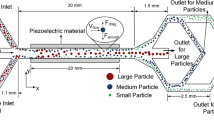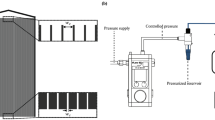Abstract
A computational study is reported on the dynamics of particles near the entrance of a microchannel, as used in microfluidic flow systems. The collision of particles with fins separating the microchannels in these entrance regions makes them particularly susceptible to particle fouling. The study employs a soft-sphere discrete-element method with van der Waals and electric double-layer forces between the particles and the wall. A multi-block-structured grid fit to the flow domain boundaries is used to compute the fluid velocity field using a finite-volume method. The fluid flow is interpolated onto a Cartesian grid for efficient flow field interpolation at the particle locations, and a level-set method is used to represent the flow field boundaries in the particle computation. Particles adhering to the upstream face of the fin separating two microchannels are found to form clusters, which are pulled laterally by the stagnation-point flow near the fin. Even under conditions where the adhesion is sufficiently strong that there is little or no particle rolling on the fin face, the particles are still removed from the fin due to collisions with other particles. Individual particles are removed quickly from the fin face due to collision with upstream particles, whereas particle clusters have sufficient adhesion force with the fin surface that they can withstand collision with other particles for longer periods of time before they are removed in a cascade-like process.











Similar content being viewed by others
References
Allievi A, Bermejo R (1997) A generalized particle search-locate algorithm for arbitrary grids. J Comput Phys 132:157–166
Bacchin P, Marty A, Duru P, Meireles M, Aimar P (2011) Colloidal surface interactions and membrane fouling: investigations at pore scale. Adv Colloid Interface Sci 164:2–11
Bai B, Luo Z, Lu T, Xu F (2013) Numerical simulation of cell adhesion and detachment in microfluidics. J Mech Med Biol 13(1):13500002
Bergendahl J, Grasso D (2000) Prediction of colloid detachment in a model porous media: hydrodynamics. Chem Eng Sci 55:1523–1532
Chesnutt JKR (2009) Discrete-element model of red blood cell aggregation in blood flow. Ph.D. dissertation, University of Iowa, Iowa City, Iowa, USA
Chokshi A, Tielens AGGM, Hollenbach D (1993) Dust coagulation. Astrophys J 407:806–819
Dahneke B (1971) The capture of aerosol particles by surfaces. J Colloid Interface Sci 37(2):342–353
Di Felice R (1994) The voidage function for fluid-particle interaction systems. Int J Multiph Flow 20:153–159
Ding W, Zhang H, Cetinkaya C (2008) Rolling resistance moment-based adhesion characterization of microspheres. J Adhes 84:996–1006
Dominik C, Tielens AGGM (1995) Resistance to rolling in the adhesive contact of two elastic spheres. Philos Mag A 92(3):783–803
Ferry J, Balachandar S (2001) A fast Eulerian method for disperse two-phase flow. Int J Multiph Flow 27:1199–1226
Hermansson M (1999) The DLVO theory in microbial adhesion. Colloids Surf B 14:105–119
Huang B, Yao Q, Li SQ, Zhao HL, Song Q, You CF (2006) Experimental investigation on the particle capture by a single fiber using microscopic image technique. Powder Technol 163:125–133
Israelachvili J (1991) Intermolecular and surface forces, 2nd edn. Academic Press, London
Issa R (1985) Solution of the implicit discretized fluid flow equations by operator splitting. J Comput Phys 62:40–65
Johnson KL, Kendall K, Roberts AD (1971) Surface energy and the contact of elastic solids. Proc R Soc Lond A 324:301–313
Joseph GG, Zenit R, Hunt ML, Rosenwinkel AM (2001) Particle-wall collisions in a viscous fluid. J Fluid Mech 433:329–346
Kim M-G, Kim Y-H, Park CW, Kim H-L, Kang D-H, Hwang J, Kim Y-J (2013) An integrated microchannel with continuous electrodynamic anti-adhesion capability for particle loss reduction in air-based microfluidic chips. J Adhes Sci Technol 27(23):2517–2530
King MR, Leighton DT (1997) Measurement of the inertial lift on a moving sphere on contact with a plane wall in a shear flow. Phys Fluids 9(5):1248–1255
Konstandopoulos A (2000) Deposit growth dynamics: particle sticking and scattering phenomena. Powder Technol 109:262–277
Lai YG (2000) Unstructured grid arbitrarily shaped element method for fluid flow simulation. AIAA J 38(12):2246–2252
Li Q, Kim KS (2009) Micromechanics of rough surface adhesion: a homogenized projection method. Acta Mech Solida Sin 22(5):377–390
Li SQ, Marshall JS (2007) Discrete element simulation of micro-particle deposition on a cylindrical fiber in an array. J Aerosol Sci 38:1031–1046
Liu G, Marshall JS, Li SQ, Yao Q (2010) Discrete-element method for particle capture by a body in an electrostatic field. Int J Numer Meth Eng 84(13):1589–1612
Marshall JS (2007) Particle aggregation and capture by walls in a particulate aerosol channel flow. J Aerosol Sci 38:333–351
Marshall JS, Li S (2014) Adhesive particle flow: a discrete element approach. Cambridge University Press, New York, pp 147–150
Marshall KC, Scott R, Mitchell R (1971) Mechanism of the initial events in the sorption of marine bacteria to surfaces. J Gen Microbiol 68:337–348
Maxey MR, Riley JJ (1983) Equation of motion for a small rigid sphere in a non-uniform flow. Phys Fluids 26(4):883–889
Perry JL, Kandlikar SG (2009) Fouling and its mitigation in silicon microchannels used for IC chip cooling. Microfluid Nanofluid 5:357–371
Ramarao BV, Tien C, Mohan S (1994) Calculation of single fiber efficiencies for interception and impaction with superposed Brownian motion. J Aerosol Sci 25(2):295–313
Serayssol J-M, Davis RH (1986) The influence of surface interactions on the elastohydrodynamic collision of two spheres. J Colloid Interface Sci 114(1):54–66
Sethian JA (1996) A fast marching level set method for monotonically advancing fronts. Proc Natl Acad Sci 93:1591–1595
Sharp KV, Adrian RJ (2005) On flow-blocking particle structures in microtubes. Microfluid Nanofluid 1:376–380
Stamm MT, Gudipaty T, Rush C, Jiang L, Zohar Y (2011) Particle aggregation rate in a microchannel due to a dilute suspension flow. Microfluid Nanofluid 11:395–403
Thornton C (1991) Interparticle sliding in the presence of adhesion. J Phys D Appl Phys 24:1942–1946
Tsiang RC, Wang C-S, Tien C (1982) Dynamics of particle deposition in model fiber filters. Chem Eng Sci 37(11):1661–1673
Tsuji Y, Tanaka T, Ishida T (1992) Lagrangian numerical simulation of plug flow of cohesionless particles in a horizontal pipe. Powder Technol 71:239–250
Wen CY, Yu YH (1966) Mechanics of fluidization. Chem Eng Prog Symp Ser 62(62):100–111
White FM (2006) Viscous fluid flow, 3rd edn. McGraw-Hill, New York, p 148
Wyss HM, Blair DL, Morris JF, Stone HA, Weitz DA (2006) Mechanism for clogging of microchannels. Phys Rev E 74:061402
Yang M, Li SQ, Yao Q (2013) Mechanistic studies of initial deposition of fine adhesive particles on a fiber using discrete-element methods. Powder Technol 248:44–53
Acknowledgments
This work was supported by NASA EPSCoR under projects NNX13AD40A and NNX12A115A, and by the National Science Foundation under projects CBET-1332472 and DGE-1144388.
Author information
Authors and Affiliations
Corresponding author
Rights and permissions
About this article
Cite this article
Marshall, J.S., Renjitham, S. Simulation of particulate fouling at a microchannel entrance region. Microfluid Nanofluid 18, 253–265 (2015). https://doi.org/10.1007/s10404-014-1428-5
Received:
Accepted:
Published:
Issue Date:
DOI: https://doi.org/10.1007/s10404-014-1428-5




